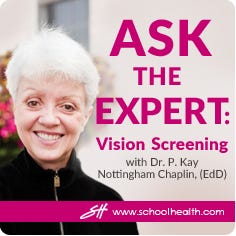Ask the Expert: Vision Screening with Dr. P. Kay Nottingham Chaplin, (EdD)
- Mar 22, 2016
- 0 Comments

School Health is pleased to bring you this “Ask the Expert” blog with Dr. P. Kay Nottingham Chaplin, (EdD), director of Vision and Eye Health Initiatives for School Health and Good-Lite, member of the Advisory Committee to the National Center for Children’s Vision and Eye Health (NCCVEH) at Prevent Blindness, and co-chair of the NCCVEH Education/Data Subcommittee.
In this blog, Dr. Nottingham Chaplin will address a few commonly asked questions about vision screening, guidelines, and best practices.
Q: What is the difference between optotype- and instrument-based vision screening?
A: Optotype-based screening is the name for screening with tests of visual acuity, commonly known as eye charts. Software tests of visual acuity, such as EyeSpy 20/20™, are also available for optotype-based screening. “Optotype” is the name for pictures, letters, or numbers on tests of visual acuity.
Recognition visual acuity is the quantifiable, subjective measurement of the clarity, or clearness, of vision at the brain level when identifying black optotypes on a white background using specific sizes at a prescribed and standardized distance.
Instrument-based screeners neither measures visual acuity nor provide reports with visual acuity values (i.e., 20/XX). Instead, these devices analyze light reflecting from the retina at the back of the eye. This analysis provides information about the presence of risk factors in the eyes that may lead to decreased vision or amblyopia.
Instrument-based screening devices, such as the Welch Allyn® Spot™ Vision Screener, measure both eyes simultaneously and provide objective information about:
- Significant refractive errors (i.e., hyperopia, myopia, and astigmatism);
- Asymmetry of the refractive error from one eye to the other, known as anisometropia (for example, one eye may be myopic and the other hyperopic);
- Misalignment of the eyes;
- Presence of media opacities (i.e., cataract); and
- Anisocoria (unequal pupil size).
Q: Do national guidelines or recommendations exist for instrument-based screening?
A: Two national guidelines or recommendations currently exist.
In 2015, the National Expert Panel (NEP) to the National Center for Children’s Vision and Eye Health at Prevent Blindness published recommendations for lay screeners, nurses, and others who screen children in educational, public health, or primary health care settings.
The NEP paper states that when screening children ages 3, 4, and 5 years, instrument-based screening is useful for shy, non-communicative, or preverbal children who cannot participate in optotype-based screening.
A guidance document from the American Academy of Pediatrics (AAP), American Association of Certified Orthoptists, American Association for Pediatric Ophthalmology and Strabismus, and the American Academy of Ophthalmology was published in 2016 for screening the vision of infants, children, and young adults. The AAP guidelines are for pediatricians and primary care physicians.
The AAP guidance document states:
- Instrument-based screening can begin with children as young as age 12 months, although screeners will likely be more successful engaging a child at age 18 months.
- At age 3 years, distance optotype-based screening may be attempted or the child can be screened with an instrument.
- At ages 4 and 5 years, either distance optotype-based or instrument-based screening may be used.
- At ages 6 years and older, optotype-based screening remains the preferred method, but instrument-based screening may be used when children and young adults cannot participate in optotype-based screening.
- Instrument-based screening may be a helpful alternative when screening children of any age who have development delays.
Q: If I use an instrument, such as the Welch Allyn® Spot™ Vision Screener, do I need eye charts?
A: Screeners cannot successfully screen 100% of children with tests of visual acuity. Similarly, screeners cannot successfully screen all children with an instrument. Reasons may be related to pupil size, environmental lighting, and a child’s ability to fixate on the device’s target.
If you primarily conduct instrument-based screening, you want a test of visual acuity, such as an eye chart or Eye Spy 20/20, as a back-up jto be used if you cannot capture an reading with an instrument. For example, if an instrument has a 90 percent capture rate, a test of visual acuity will enable you to screen the other 10 percent of children the same day.
Whether you prefer optotype- or instrument-based screening, or a combination of the two approaches, a key to successful vision screening is using evidence-based tools and procedures as one of 12 components of a strong vision and eye health system of care. You can also use this checklist to evaluate your annual vision health program.
The right screening tools give us an important leg-up for identifying potential visual impairments. Screening with evidence-based tools helps ensure that we find and treat children with vision challenges so that all can learn and perform to the best of their abilities.
School Health offers a wide variety of optotype- and instrument-based screening tools to meet your needs. Click here to see our full line of vision screening products.
If you have a question that was not answered above, please let us know in the comment section below and we will research the answer.
Keep in touch with Dr. Kay!
|
For more information and references:
